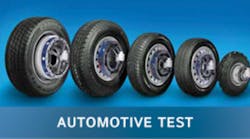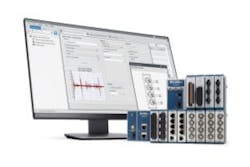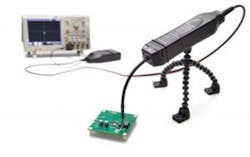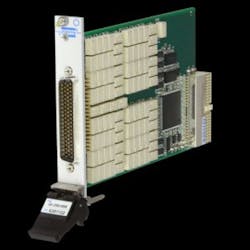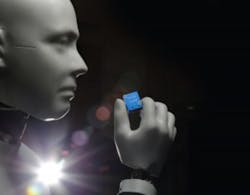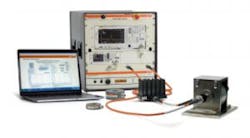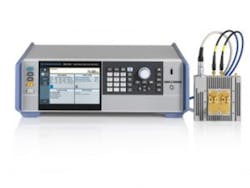Is it a car, or a mobile datacenter? The automobile is undergoing profound changes on the road to electrification and autonomy, vastly complicating the job of design and test engineers. An automotive project today can begin with software simulation, negating the need to begin by building mechanical prototypes to monitor during road tests or observe in wind tunnels. Before any metal is bent, software simulations can help optimize everything from battery chemistry to vehicle aerodynamics. As simulation proceeds, so, too, does the development of robust, reliable, safe embedded code.
Following operation in the virtual environment of software simulation, physical components, subsystems, and systems begin to emerge. They may begin in a hardware-in-the-loop environment, in which, for example, you test a physical ECU with software controlling all of the ECU’s inputs and responding to its outputs—without the need for an engine, for
example, or an external severe climate in which a normal vehicle must operate. Here, physical instruments begin to come into play that can simulate sensors, for example, or insert electrical faults that mimic what a real vehicle’s electrical system might exhibit after years of vibration and corrosion.
And, of course, traditional instruments will have a role to play in everything from power electronics to infotainment devices—from R&D to high-volume manufacturing test of power electronics modules and V2X communications and infotainment devices. And physical road tests remain a necessary part of the development effort, requiring data acquisition and analysis.
And it should be emphasized that what might seem to represent distinct phases of the design and test effort—software simulation, embedded software development, HIL test, road tests, manufacturing test—don’t operate in silos. For example, even as autonomous-vehicle pioneer Waymo and its competitors have manufactured and fielded fleets of test vehicles that have logged millions of miles of physical road tests, these companies are simultaneously logging billons of virtual miles in software simulation environments.
For this article, subject-matter experts in various phases of the automotive design through test effort have offered their viewpoints on the changing automotive development and manufacturing environment.
“The automotive industry is transitioning from a complex mobility platform into a complex IT platform,” said Frederic Weiller, automotive and energy solutions lead, Keysight Technologies Inc. “Increased safety, reliability, and environmentally friendly options are increasing the demand on automotive designers to fully embrace those technologies that are part of the connected car and the objective for autonomous vehicles.”
“The automotive industry is undergoing major changes with regards to connectivity, electrification, and autonomous driving,” according to Shah Hassan, automotive segment lead at Tektronix. “Data rates are increasing, and technologies that originated in datacenters are being re-engineered for automotive environments,” he said. “New challenges for electronic systems are being brought about by electrification and advanced driver- assist systems.”
“A new era of mobility is upon us,” said Jeff Phillips, head of automotive marketing at National Instruments. “Critical technology trends in ADAS, EV, and V2X are bringing with them new test challenges and pressures beyond the here and now. The quickly evolving technology landscape increases the pressure to any test schedule and requirements. NI ensures that test managers are confident in their ability to overcome the pressure of rapidly changing test requirements, using an open and easily upgradable platform that is designed for test system openness and flexibility.”
Phillips continued, “We’ve seen automotive companies employ a variety of tactics to
overcome these challenges, but the one that comes to the forefront is intent to introduce more automation into the validation process.” He cited a recent case study that highlighted how Mazda reduced the man-hours related to manual operations by 90%, resulting in hundreds of millions of yen saved per year.1
“As you look across the product development process, we have traditionally served needs across the entire spectrum with the openness of LabVIEW, but our products are laser-focused on the validation test and EOL production test of automotive components,” Phillips said. “This includes testing at Tier 1 and OEMs, both component-level and vehicle-level for integrated systems testing.”
According to Lawrence I. Williams, Ph.D., director of technology at the ANSYS Electronics Business Unit, “The two great changes in automotive are the ongoing electrification transformation and the drive toward autonomous systems.” ANSYS, he said, has a long history of contribution for each for the four pillars of electrification—battery, power electronics, electric motors, and electric powertrain integration—offering a virtual environment that enables design teams to deliver on all pillars.
Speaking specifically about autonomous vehicles, Williams said, “Ensuring safety must include very rigorous testing in this virtual environment. Indeed, many of the suppliers of autonomous vehicle technology are now rethinking their approach and working to provide much greater assurance of safety prior to on-road testing.” (Williams’s colleague Sandeep Sovani, global director, automotive industry, elaborates on autonomous vehicles and relates how ANSYS assisted in the recent record-setting run of Volkswagen’s all-electric I.D. R Pikes Peak racecar in the Simulation feature this month.)
Active safety is an area highlighted by Paul Bovingdon, simulation product manager for Pickering Interfaces. “Advanced emergency braking system (AEBS) or autonomous emergency braking (AEB) and other collision-avoidance technologies require more extensive testing and verification of design features to ensure the vehicle occupants’ safety,” he said. “Regarding switching in test, these technologies need higher bandwidth than was needed in the past, including fault-insertion techniques and reliable, repeatable switching. In addition, we find more and more requirements for sensor simulation for testing battery-management systems (BMS) to replace the temperature sensors in the battery pack during test. This is one of the primary reasons we will continue to expand our sensor-simulation product line in 2018 and into the future.”
Pickering’s products span HIL test, R&D, and manufacturing test. For HIL, the company offers PXI fault-insertion switching that can be used to introduce electrical faults into a system. “This test process typically duplicates various conditions that can occur because of corrosion, short/open circuits, and other electrical failure inherited through age, damage, or even faulty installation,” he said. Also for HIL, the company offers PXI and PCI programmable resistor modules for sensor simulation. “An HIL system employed to test an ECU needs to simulate the behavior of these sensors as accurately as possible to ensure that the ECU behaves on the test bench exactly as it would when operating in the real world,” he said. “Our programmable resistors do just that.”
For R&D, he said, the increasing feature sets of automobiles—including Bluetooth and adaptive cruise control—call for RF and microwave switching in test. “We offer over 300 PXI and LXI RF solutions ranging from 500 MHz to 65 GHz, so we can address the vast majority of RF and microwave applications with our standard offerings.” And finally, for manufacturing test, he said, “We offer a comprehensive catalog of general-purpose, multiplexer, and matrix switch modules, including a range of 2-A, 300-V modules which are commonly used in ECU testing.”
Rob Mydzian, director of sales and marketing, Automotive Division, PCB Piezotronics, agreed that a worldwide focus is on electric and autonomous vehicles, and he said his company is designing new sensors to meet the new requirements for isolation and safety. He mentioned hybrid vehicles as well. “However, the internal-combustion engine is not going away, and powertrain measurements remain critical to vehicle development,” he said. “Our low-thermal-coefficient line of sensors is perfectly suited to the complex challenges that come with these applications. Using specialized filtering and proprietary low-temperature-coefficient crystals, we are able to offer outstanding specifications and sensitivity across a wide temperature range for this application.”
Teledyne LeCroy’s focus on the automotive industry led it to announce in October 2016 the creation of an Automotive Solutions Group, along with the opening of a new Automotive Technology Center in Farmington Hills, MI, according to Hilary Lustig, marketing communications manager. She said the group’s core competencies aim at helping companies advance the development and use of a range of technologies within the connected car. At the Farmington Hills center, she said, staff can help test and troubleshoot mechanical and drivetrain systems as well as servo and motor controls. The staff can also address cybersecurity issues, help meet technology conformance and compliance challenges, and help to identify and resolve safety concerns. “The end goal of the Automotive Solutions Group is to improve overall customer vehicle ratings across key categories, including safety, security, durability, performance, conformance, interoperability, and reliability,” she said.
Core suite of simulation tools
As for specific ANSYS products, Williams said, “ANSYS has built a core suite of tools that address electronic design in automobiles. Our ANSYS Electronics Desktop houses flagship electronics tools like ANSYS HFSS, ANSYS HFSS SBR+, Maxwell, and Icepak. They are used for physical design of electronics, wireless communication systems, the electric powertrain, and radar.”
Williams continued, “Antenna design, placement, and the presence of other antennas in their vicinity significantly affect the overall efficiency of the wireless communication systems aboard these vehicles. Modern vehicles have many electronic systems that must not interfere with each other. For example, passengers will bring their mobile devices into the cabin. Comprehensive electromagnetic interference modeling due to use of wireless devices like smartphones and other equipment can be performed using ANSYS HFSS and ANSYS SIwave. These ANSYS tools can investigate issues related to EMI and coupling among electronics.”
Williams added, “ADAS systems could feature large touchscreen control panels for information and vehicle control. ANSYS Q3D Extractor is used across the electronics industry to design and simulate touchpanels for evaluating capacitance, sensitivity, and robustness. Q3D can be combined with optimization to perform design exploration for best performance.”
Williams also emphasized, “Electronic systems get hot. ANSYS Icepak is used to predict electronics cooling using the Fluent computational fluid dynamics solver to deliver highly accurate prediction of cooling strategies.”
He added that beyond electrical and physical design, modern electronic modules have embedded firmware and software. “The functional behavior of those systems is only as good as the software that has been embedded,” he said. For embedded software, Williams said ANSYS provides SCADE Suite embedded code generation and system simulation and Medini Analyze for functional safety. “SCADE Suite provides a model-based development environment for critical embedded software,” he said. “The Scade language is used within the integrated design environment for critical applications including requirements management, model-based design, simulation, verification, qualifiable/certified code generation, and interoperability with other development tools and platforms. It is used to design critical software, such as engine-control systems, automatic cruise control, power and fuel management systems, displays, emergency braking systems, and ADAS in cars. SCADE Suite drastically reduces project certification costs by automatically generating standards-compliant embedded code.”
ASNYS also addresses failure-analysis techniques including hazard and operability analysis; fault-tree analysis; failure-mode and effects analysis; and failure modes, effects, and diagnostics analysis. “ANSYS Medini Analyze implements key safety analysis methods (HAZOP, FTA, FMEA, FMEDA) in an integrated tool for efficient and consistent execution of the safety-related activities required by applicable safety standards,” Williams said. “Medini Analyze is applied in the development of safety-critical electrical and software-controlled systems and is specifically tailored to the automotive standard ISO 26262. The application scope ranges from the early conceptual phase through product development all the way down to detailed analysis on the semiconductor level.”
ANSYS has a comprehensive platform for reliable automotive design, according to Williams. “Our semiconductor tools are the industry standard for advanced-node SoC power integrity; our physics-based solvers are the foundation for electrical, thermal, mechanical, and fluid dynamics design; our embedded software suite allows engineers to build standards-compliant programming; and our systems tools provide comprehensive analysis of the full automotive system. From mechanical design of automotive suspensions to external aerodynamics to underhood thermal or IC engine combustion and integrated electronics, ANSYS provides a full spectrum of solutions for the auto industry.”
He added that ANSYS recently acquired Optis, a leader in the design of optical components, lighting, and autonomous vehicle simulation. “We have integrated our ANSYS HFSS and ANSYS HFSS SBR+ into the Optis VRX virtual-driving environment to provide accurate radar modeling alongside camera and lidar simulation,” he said.
Instruments at Automotive Testing Expo
When asked about specific products for automotive test applications, Weiller at Keysight said, “Our solutions include a wide variety of laboratory bench equipment, flexible modular designs, and handheld portable test equipment.” He continued, “Keysight automotive test solutions encompass the entire product life cycle for electronic test and measurement.”
The Automotive Testing Expo 2018, scheduled for Oct. 23-25 in Novi, MI, will provide Keysight and 300 other vendors the opportunity to highlight their recently introduced products for automotive test applications.
At the expo, Weiller said, Keysight will exhibit its latest test and measurement solutions relating to e-mobility, autonomous driving, the connected car, and automotive electronics in general. “Some of our test solutions will focus on battery and EV infrastructure, automotive radar, V2X communications, automotive Ethernet, and electronic board testing,” he said.
One highlight of Keysight’s exhibit will be a compact and scalable PXIe solution for Dedicated Short-Range Communications (DSRC) Certificate Operating Council (COC) testing, which provides full coverage of DSRC radio-frequency measurements and protocol testing. “The compact PXIe hardware reduces footprint and increases test density and covers all COC test cases in single, integrated PXI frame that’s an expandable platform for future V2X test needs,” he said.
Keysight also recently introduced the E6950A eCall Conformance Test Solution, which is based on the E7515A UXM wireless test set. The solution can emulate and analyze a range of complex network operations. However, Weiller said the solution for next-generation European emergency call system will not be on display at the North American event.
Teledyne LeCroy will exhibit a variety of products at the expo, including oscilloscope solutions for automotive Ethernet, lidar, ADAS, and automotive serial decoding. “Modern vehicles depend greatly on low-speed serial data protocols such as CAN, LIN, and FlexRay for communication between an ECU and various sensors and subsystems,” said Lustig. “Our Automotive Trigger and Decode bundle provides selected Teledyne LeCroy oscilloscopes with powerful trigger and decode facilities for these protocols, enabling rapid debugging and validation.”
She continued, “Our new WavePro HD oscilloscope features 12-bit resolution all the time up to 8 GHz with 5 Gpts of memory to make sure you never miss a detail.”
In addition, she said, “We will show our MDA800A motor drive analyzer (MDA), which is an oscilloscope plus power analyzer in one instrument. You can perform static power analysis (like a power analyzer), dynamic power analysis (unique to the MDA), and complete system debug (unique to the MDA).”
Wireless testing will also be highlighted at the Teledyne LeCroy booth. “With the Frontline Sodera wideband Bluetooth protocol analyzer you see all Bluetooth traffic on all channels—everything that is in the air,” she said. Users can view inquiry and paging packets along with all Bluetooth Low Energy and all Bluetooth BR/EDR (basic rate/enhanced data rate) packets. “See them all simultaneously as they happen,” she said.
Phillips at NI said the company has introduced several products within the past few months that are relevant to automotive test and will be on display at the expo. The company will also highlight its partners, which he described as providing critical integration services and software development based on NI’s software-designed platform.
He described several specific products that the company will exhibit. “FlexLogger is a configuration-based data-logging software targeting ad hoc measurements for the validation of physical systems,” such as those prevalent in automotive applications, he said. “FlexLogger is designed for technicians to configure and execute measurement and logging tasks without the need for programming.”
He described SystemLink as server-based software designed for distributed systems management, which presents a growing challenge for automotive applications as new validation labs and remote end-of-line manufacturing facilities are being spread throughout the globe. “SystemLink aims to improve the operational efficiency and decrease maintenance costs by centralizing and automating tasks for software deployment, remote device configuration, and even monitoring system health performance,” he said.
Also on display will be CompactRIO with DAQmx—a new measurement and control platform that combines the reconfigurable FPGA of the CompactRIO with the ease of use of the DAQmx driver API for the host side of the application. “Simply put, this combines the best of both worlds from CompactDAQ and CompactRIO, while upgrading the controllers with TSN capabilities for network determinism and reliability,” he said.
“Finally, the Vehicle Radar Test System (VRTS) is a preconfigured collection of NI products and IP specifically designed for testing radar technology in the 76- to 81-GHz range, from the validation lab through high-volume production test,” he said. “The VRTS covers individual radar sensors all the way to integrated ADAS systems. One of the key advantages of the VRTS is the ability to provide dynamic obstacle generation and comprehensive RF characteristic measurements on top of the standard simulators that only work for functional behavioral test.”
Hassan at Tektronix said his company will exhibit solutions for connected-vehicle and in-vehicle network testing, electric-vehicle and powertrain testing, and autonomous-vehicle and radar and lidar testing. “For the connected-vehicle and in-vehicle network test, we have solutions that support Ethernet compliance testing, SENT bus troubleshooting, CAN FD bus troubleshooting, as well as EMI and EMC precompliance testing with our EMCVu software.”
For the electric-vehicle and powertrain side, he said, the company offers solutions for testing battery chargers, DC/DC converters, and EV/HEV inductive charging solutions. He added, “For the autonomous vehicle and radar and lidar module testing side, we provide both hardware and software solutions that allow you to generate signals to test your modules as well as ensure linearity in your radar devices.”
Mark Elo, technical marketing manager at Tektronix, cited several specific products that the
company will exhibit. “The 2650 source-measure unit simulates changes in supply voltage seen by the electrical and/or electronic components, subsystems, and ECUs of the automobile when the engine is being started and as part of power-cycling test requirements,” he said. “The 2650 source-measure unit is an all-in-one ignition-emulating power supply that can simultaneously source/measure current and voltage and thus be used to test the effects of interference from the ignition system on components, subsystems, and ECUs.”
The 5 Series MSO and new 6 Series MSO oscilloscopes with ISOVu probes will also be on display in a demonstration of super-fast-switching power-device measurements on technologies such as SiC and GaN used in power electronics for EV/HEVs. “The ISOVu probing system galvanically isolates differential-voltage measurement, which allows you to make very accurate measurements on extremely high-power switching electronics and in face of high common-mode voltage,” he said. “Its unique isolating design with extremely high common-mode rejection allows you to visualize switching anomalies which could not previously be seen.”
The company will also demonstrate packet-level triggering and serial-bus protocol test of CAN FD, LIN, and FlexRay buses using the 5 Series and 6 Series scopes. “Higher sample rates and lower noise-floor specifications are critical in automotive ECUs,” he said. In addition, he explained, the MSO Series can provide key performance indicators of the performance of the serial bus, other systems, and other instruments by triggering on packet-level events.
The company will also highlight the RSA300/500 real-time spectrum analyzer and the MDO4000 Series oscilloscope for EMI compliance test and EMI debug. The instruments, Elo said, “…allow you to easily visualize EMC/EMI-related issues; combined with advanced serial-bus triggering and ignition-system emulation on power-supply lines, [you can] drive to the root cause of radiated emissions much faster.”
Finally, the company will demonstrate advanced radar waveform generation and analysis with the 70000 Series arbitrary waveform generators and oscilloscopes. “The move from 24-GHz to the 70-GHz spectrum provides the ability to improve the resolution of the radar by increasing the linear frequency modulation from around 200 MHz to 4 GHz,” Elo said. “Tektronix arbitrary waveform generators and oscilloscope provide the bandwidths and the measurement quality to accurately simulate targets or to validate the linearity of the signal being transmitted.”
Signal switching for simulation and test
“The products and demonstrations in the Pickering booth will emphasize our leadership in signal switching and simulation for test,” said the company’s Bovingdon. He described several specific products, including the Model 40-202 2-A PXI fault-insertion modules, introduced this year. “These modules were primarily designed to simulate fault conditions in automotive and avionics test applications involving the reliability testing of safety-critical controllers,” he said. “They are specifically designed with the capability to insert three different types of fault conditions on pairs of signals between the test fixture and the equipment under test: open-circuit, short-circuit between signal pairs, and short-circuit to user-applied fault conditions such as power or ground.”
The 40-200 and 40-201 PXI fault-insertion switching modules, designed for use with
differential serial interfaces, will also be on display. “The differential PXI fault-insertion switch (Model 40-200) is designed for lower data-rate serial interfaces such as CAN and FlexRay, and the high-bandwidth differential PXI fault-insertion switch (Model 40-201) is designed for higher data-rate serial interfaces such as BroadR-Reach, AFDX, and 1000BaseT Ethernet,” Bovingdon said.
He described the 40-200 and 40-201 as “…unique in that they are the only impedance-controlled fault-insertion switches in PXI that address differential serial-bus requirements for transportation applications such as CAN, FlexRay, or Ethernet for automotive.” He added that PCI equivalents are available for smaller-system/lower-cost requirements. “Given the nature of the intended application, our software driver defaults to a protective mode where specific connections are inhibited to avoid accidentally shorting unintended paths, such as power to ground,” he explained. “A separate mode enables complete freedom in setting fault patterns.”
He continued, “Examples of our broad range of PXI and PCI programmable resistance modules will be on hand, including both new and existing products. These modules offer up to 18 channels in a single PXI/PCI slot, resistance ranges from 1 Ω to 22 MΩ, and resolutions down to 2 mΩ with accuracies as high as 0.03%.” The product families range from simple resistor ladder circuits to precision modules that can simulate RTD devices, strain gauges, and other sensors used in transportation applications.
“In addition, we will have our new 6-slot USB/LXI chassis on display,” he said. “This chassis complements our recently released 2- and 4-slot USB/LXI modular chassis, and its compact full-rack-width 1U form factor is ideal for space-restrictive applications. These chassis feature USB and LXI Ethernet interfaces, enabling simple direct control from most personal computers. The new 6-slot chassis supports between one and six of Pickering’s 1,000+ 3U PXI modules, with possible configurations including a switching matrix of up to 3,312 crosspoints or 108 channels of programmable resistor/sensor simulation.”
The company will also exhibit its Model 41-760 PXI millivolt thermocouple simulator modules, available in a choice of 8, 16, 24, or 32 channels—each channel providing a low-voltage output across two connector pins capable of providing ±20 mV with 0.7-µV resolution, ±50 mV with 1.7-µV resolution, and ±100 mV with 3.3-µV resolution, covering most thermocouple types.
Bovingdon summed up the company’s product offerings by citing breadth and range. “For example, our PXI range of fault-insertion switches is by far the largest available in the industry, comprising 15 product families with 62 options in total,” he said, adding that programmable resistance offerings (typically used for simulating remote sensors) comprise 130 options in PXI and 120 in PCI. “Our philosophy has always been to offer optimal functionality, with the required level of performance, at the most competitive price—in other words, offering the most efficient solution.”
Data acquisition and sensors
Diversified Technical Systems (DTS) will exhibit its ultracompact SLICE6 high-shock Ethernet data-acquisition system at the Automotive Testing Expo. Developed for the U.S.
Army’s WIAMan (Warrior Injury Assessment Manikin), the first vertical-load anthropomorphic test device (ATD), SLICE6 caught the attention of the automotive industry when the National Highway Traffic Safety Administration (NHTSA) contracted DTS in 2017 to integrate the THOR-50M (Test device for Human Occupant Restraint 50th percentile adult male) ATD with the SLICE6. DTS said SLICE6’s ultracompact design and integration reduces in-dummy cabling and connectors.
DTS reported that with today’s higher channel-count tests, ATD manufacturers are also embracing embedded solutions. The new Euro NCAP iTHOR Model 477, scheduled to be available in the fall, is being manufactured to universally accept several in-dummy DAS solutions, including SLICE NANO and SLICE6 from DTS. In addition, SLICE6 is designed to work with both the NHTSA and Euro NCAP lumbar adjustment design. Several SLICE6 integration kits are available to support 118, 135, 139, 151, and 156 channels as well as the 96-channel Euro NCAP and the 100-channel NHTSA configurations. Integration can be done by the ATD manufacturer, in-house at DTS, or by the customer.
“We are definitely seeing SLICE6 shift from its origins in blast testing to becoming a standard in automotive safety testing,” said Steve Pruitt, DTS president and cofounder, in a press release.
Mydzian at PCB Piezotronics said his company at the expo would highlight the new SWIFT Evo wheel-force transducer for spinning and nonspinning automotive applications. “The
SWIFT Evo has evolved from the original MTS Systems Corp. SWIFT WFT that has an outstanding reputation for saving time and money during testing,” he said. “The core features, such as easy installation and outstanding data accuracy, remain.” The new SWIFT Evo features improvements such as enhanced thermal stability, the addition of transducer electronic data sheet (TEDS) functionality, and a new graphical user interface. “Additionally, the SWIFT Evo is designed for all MTS 329 test rigs, as it can be used both on the test track and in the laboratory,” he said. “With PCB Piezotronics now part of the MTS family, the SWIFT Evo will be backed by a strong global team and have 24/7 customer service, rental, consulting, calibration, repair, and trade-in available for all customers. Customers will benefit from enhanced performance, sophisticated functionality, and unmatched reliability, thereby increasing the integrity and consistency of their product-testing data.” PCB’s products, he said, are used during the research and development phase of testing.
Focusing on EMC test
AR/RF Microwave Instrumentation will also exhibit at the show. AR’s exhibits will include its new U Series broadband Class A amplifiers, the new MT06002 MultiStar multi-tone test
system, and the new CI00402 conducted susceptibility test system, according to Joe DiBiase, manager, EMC applications and systems.
“AR manufactures a wide selection of the highest power and broadest frequency-range RF and microwave amplifiers in the industry,” he said, thereby providing customers with the flexibility they need to select the correct amplifier to achieve the field strengths necessary for full vehicle testing and component test. “For example, our new U Series class A solid-state CW amplifiers operate from 10 kHz to 1 GHz, at power levels ranging from 1 W to 250 W,” he said.
Test throughput is one benefit of AR’s offerings. DiBiase said the multitone test system offers greater testing efficiency with an increase in instantaneous bandwidth to 1 GHz and the extension of the frequency range down to 10 kHz. “These features, along with new test profiles, offer automotive manufacturers the ability to significantly increase conducted and radiated susceptibility test throughput,” he said. And commenting on the new CI00402, he added, “This conducted-immunity system has the same flexibility as previous versions but produces faster measurements and contains a fully functional spectrum analyzer, all at a lower price.”
DiBiase said the company will also showcase a new antenna, the ATT700G8. “This is a pyramidal log antenna operating from 700 MHz to 8 GHz, designed for EMC emissions and immunity testing,” he noted. “This antenna provides excellent power handling capability for L- and S-band RF susceptibility testing.”
New solid-state pulsed amplifiers will also be on display, he said, representing an attractive alternative to TWTAs for automotive and military EMC radiated immunity and susceptibility testing. These amplifiers operate from 1 GHz to 8 GHz, he noted.
Finally, he said, “AR also manufactures complete conducted and radiated test systems, so you don’t have to worry about tying up valuable engineering resources configuring piece parts to produce your EMC test system. AR’s software, emcware, makes these systems very user friendly.”
From software to flying probers
Other companies haven’t detailed their plans for the Automotive Testing Expo, but several exhibitors have recently introduced products and technologies that they are likely to highlight at the show.
For example, dSPACE announced in July that it is one of the first embedded-software development-tool providers to support comprehensive functionality for the development and validation of some of the latest AUTOSAR 4.3 features in its products. Technologies that have posed a challenge for many developers, such as secure onboard communication (SecOC), global time synchronization (GTS), and enhanced end-to-end (E2E) protection, can now be developed and tested directly with dSPACE’s tools, the company said. In addition, dSPACE can provide support for customers and assist them in the introduction and validation of the new features.
Brüel & Kjær is likely to highlight its BK Connect software platform, introduced in February. The company described the platform as a fully integrated user-centric software solution for multichannel data acquisition, data processing, data management, and reporting. The core applications of BK Connect are designed for general-purpose sound and vibration engineering. The software also offers specialized modules for structural dynamics, noise source location, and angle domain analysis.
Pico Technology is likely to highlight its new PicoScope 5000D Series FlexRes oscilloscopes and MSOs, which feature up to 16 bits of vertical resolution with up to 200-MHz bandwidth and 1-GS/s sampling speed. FlexRes hardware employs multiple high-resolution ADCs at the input channels in different time-interleaved and parallel combinations to optimize either the sampling rate to 1 GS/s at 8 bits, the resolution to 16 bits at 62.5 MS/s, or other combinations in between. The company also offers a line of automotive oscilloscope kits; noise, vibration, and harshness (NVH) kits; and accessories.
Rohde & Schwarz recently made news on two fronts with respect to automotive test. First, the company announced it has further expanded the capabilities of its R&S CMW500 wideband radio communication tester and R&S SMBV100A GNSS simulator to support Global Certification Forum (GCF) protocol conformance tests for cellular vehicle-to-everything (C-V2X) device certification. Utilizing the Qualcomm 9150 C-V2X chipset solution, the R&S CMW500 acting as LTE network simulator now allows automakers to test C-V2X direct communications (PC5) according to GCF Work Item 281.
“C-V2X PC5 radio technology has quickly advanced to a precommercial stage, and Rohde & Schwarz is pleased to be the first test-equipment vendor to offer a comprehensive C-V2X test suite,” said Anton Messmer, vice president, mobile radio testers, Rohde & Schwarz, in a press release. “The automobile industry can now verify functionality and performance of C-V2X devices as well as start device testing as per 3GPP protocol conformance tests. This expanded capability complements our support for European eCall and shows our long-standing support for automotive applications.”
And second, the company announced that it has developed the R&S AREG100A automotive radar echo generator. The instrument is designed specifically for final test and inspection of
radar sensors on OEM and Tier 1 production lines. It tests radar sensors in the 24-GHz ISM band and in the E band at 77 GHz or 79 GHz. It simulates echoes of up to four artificial target objects at fixed distances. User-configurable Doppler offsets can optionally simulate radial movement of the objects. Customers can specify desired fixed distances at the time of order. The company described the R&S AREG100A as a future-proof solution for testing advanced long-range and short-range radars. It supports bandwidths up to 4 GHz in the E band and can simulate objects at a minimum distance of 4 m if the distance between the frontend and the DUT is 80 cm.
And finally, Seica is likely to highlight its fully automated Pilot V8 next > Series flying prober, introduced at IPC Apex Expo in January in San Diego. It provides up to 20 mobile test resources for an electronic board, including probes that can supply up to 3 A, high-resolution cameras for automatic optical inspection, barcode-reading capability, lasers, capacitive probes, pyrometers, optical fiber sensors for LEDs, flying connectors for boundary-scan and on-board programming, and high-frequency probes for measurements above 1.5 GHz.
From software to system
Design and test challenges will continue to mount as vehicle electrification continues and autonomous vehicles emerge, spanning components and code to complete systems.
With regard to software development, the authors of a recent MathWorks article cited drawbacks of traditional methodologies, which can delay the discovery of defects and make it difficult to accommodate requirements changes. They propose a combination of model-based design with agile methods and a Scrum framework. They provide an automotive-engineering example in which they apply software including MATLAB, Simulink, and the Automotive Driving System Toolbox to the development of embedded software for an adaptive cruise-control system with sensor fusion.2
As for a complete system, “Interoperability is the name of the game,” said Phillips at NI. “The challenge of testing the continually evolving technology is so great, no one company can solve it alone.” NI focuses on providing the necessary capabilities through a platform of interoperable, integrated products. “We provide a wide breadth of I/O across a multitude of computing platforms and software that spans the needs of engineers of technicians,” he said. “Unlike the closed, vendor-defined solution that have historically dominated this market, the flexibility in our platform is the only way to meet the needs of the engineer today—which is to be flexible enough to handle the challenges of tomorrow.” EE
References
For more information:
